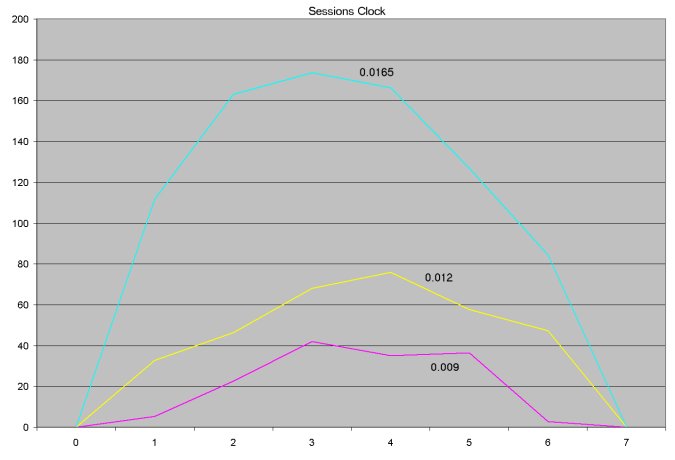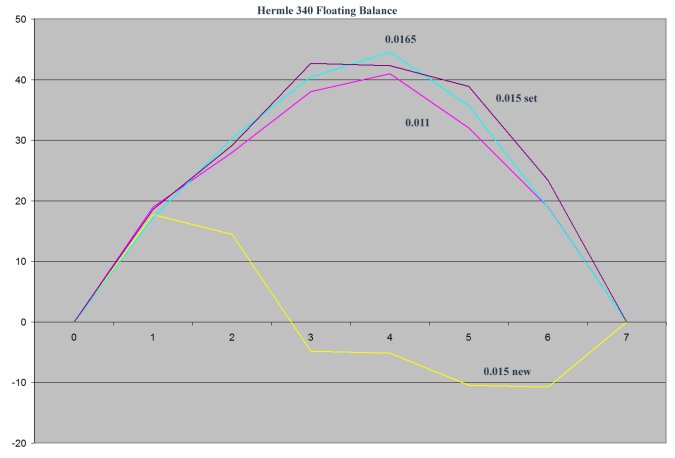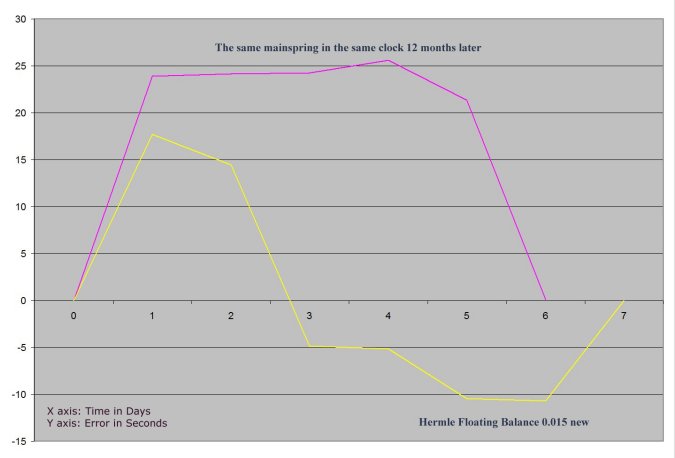Mainspring Stength and Timekeeping
As I suggested in my previous essay, using a mainspring with less strength would result in an improvement in the overall timekeeping of a mechanical clock, particularly if the clock had a recoil escapement, because the variable error would be reduced. The purpose of this essay is to show that improvement with several clocks often seen on the bench for repairs.
The first clock in this experiment was a Sessions clock from about 1910. It had a strip pallet recoil escapement and an eight-inch pendulum. When using a very strong 0.0165" thick mainspring, the clock gained a lot of time because of the arresting effect of recoil. Using a weaker 0.012" thick mainspring reduced the time gained to the point that the clock actually lost some time. The pendulum was not adjusted during the experiment in order to compare the timekeeping of the clock using mainsprings of different strengths. When an even weaker 0.009" thick mainspring was used, the clock actually gained some time because using a stronger mainspring normally causes a clock to lose time. With a recoil escapement, however, the effect of recoil causes the clock to gain more time than it would otherwise lose. On all the graphs, days one through seven are shown on the horizontal line (X axis). The timekeeping error in seconds is shown on the vertical line (Y axis). Click on each image to see the graph in full size.
 |
Since the pendulum must not be adjusted during the experiment, adjustments must be made to the data collected, afterwards. For example, an adjustment of 10 seconds per day would appear on a computer spreadsheet as 10 seconds on the first day, 20 seconds on the second day, 30 seconds on the third day, and so on, (which is all the maths you need to know to read this essay). All the results for each mainspring are adjusted using the same method, such that the error on the seventh day falls to zero. Correctly adjusted, the clock will gain time in the beginning of the week, and then lose an equal amount by the end of the week. The variable error caused by the effect of recoil is dramatic when the results of the strong mainspring are compared to the results of the weaker mainsprings. Using a mainspring that is weaker by 50% reduces variable error by somewhat more than 50%.
 |
The curves on the graph are less than perfect. This is not because of uneven mainspring strength over time, which will be addressed later. All three curves should be quite smooth, like the curve for the strong mainspring in this experiment. The flaw lies in the data collection method itself. Since the clock does not have a second hand, the data themselves have a possible error of plus or minus ten seconds. I could adjust the data further, within the twenty second parameter, to create a smoother curve, but decided not to. What you see is the data as it was collected. The data collected would vary from mainspring to mainspring and from clock to clock.
The second clock in this experiment had a Graham escapement. I used a small Sligh wall clock with a Hermle 341 mechanism from 1987. The pendulum was 24 cm. long, or almost ten inches, not much longer than the pendulum on the first clock. The Graham escapement is superior because it eliminates recoil: the escape wheel does not move backwards when the pendulum has a wide swing. The 0.015" thick mainspring showed an uneven strength over time. Rather than replace it with another new mainspring, I chose to present it here because this is one of the causes of variable timekeeping. Instead, I added another 0.015" mainspring which was "set" to the experiment. Mainsprings lose some of their strength in the first six months of use. An old mainspring, which has become set because it was not tempered properly, has lost much of its strength and will show slightly uneven windings when inside the barrel. It will not open as much as a new mainspring when outside the barrel. For timekeeping accuracy, the old set mainspring performed very well in this experiment. The thinnest mainspring (0.011" thick) in this experiment also showed an irregular performance.
 |
Here the 0.015" thick mainspring was stronger than then thicker 0.0165" mainspring on the first day, causing a greater loss of time, but rapidly losing strength on the second day. The variation in timekeeping of the other irregular mainspring (0.011" thick) became more visible after the data were adjusted. By far the greatest accuracy was observed with the set mainspring, which is ironic because a set mainspring is considered to be defective and is normally replaced.
 |
The third clock in this experiment was a Ridgeway clock with a Hermle 340 mechanism from 1982, using the same mainsprings as the second clock. This clock had a balance wheel instead of a pendulum, and the older style of balance wheel, like this one, was known as the "floating balance." Having repaired so many of them in the 1990s, I was interested in comparing this clock to the others. It is more accurate than most pendulum clocks. More importantly, it does not need to be perfectly level for it to run, and can be moved without it stopping, making this one of the most user-friendly mechanical clocks ever made. As I remember it, Hermle manufactured 800,000 clocks per year in the mid-90s, and 75% of them were of the model 340 floating balance clocks. Every collector should have a clock with a floating balance.
The timekeeping in the floating balance was not affected as much by changes in mainspring strength. The new irregular 0.015" mainspring and the old set 0.015" mainspring appeared to perform with similar accuracy.
 |
The irregularity in the new 0.015" mainspring became much more obvious when the data were adjusted. Notice, however, how close the other curves are on the graph, as if the floating balance had been adjusted for isochronism.
 |
The variable error itself will vary from mainspring to mainspring and from clock to clock. The graph below shows the 0.015" mainspring in the Hermle 340 clock when it was new, and in the same clock a year later, showing that the performance of mainsprings will change over time.
 |
The fourth clock in this experiment was a large Ridgeway grandfather clock with a Graham escapement and a 39-inch pendulum, long, big and heavy. It also had weights instead of mainsprings. The data collected for this clock had a much smaller margin of error of plus or minus one second because this clock had a second hand, which meant that the data could be collected more accurately.
 |
The variations appear more erratic in the next graph, but this is misleading because the variations are much smaller. Here the data shows that the grandfather clock had a greater variation with the 5 lb. weight than with the 10 lb. weight. This graph also shows another effect that the weights had upon the timekeeping of the clock. While there was no sympathy swing visible, there was clearly some effect. When the weights go down to the same level as the pendulum bob, and the weights can be seen to be moving from side to side like the pendulum, this is called a sympathy swing. The weights were at the same level as the pendulum bob on the sixth day. The graph shows that the clock gains time as the weights descend to the same level as the pendulum bob, peaking on the fifth day.
 |
The graph below shows how the variable timekeeping for these clocks compare. You can see that the error in the Sessions clock with the recoil escapement is much greater than in the other clocks. Note that the error in the grandfather clock is very small, negligible by comparison.
 |
These experiments were conducted in a controlled environment with very small variations in temperature because of air conditioning. Under normal use, these clocks would exhibit considerably greater variations in timekeeping between the winter months and the summer months.
There is more to learn by comparing these clocks to a 31 day clock. Read my essay about the Korean clock.
Update: The following graph shows why many clocks are far more accurate when they are wound twice a week. The clock was a 2002 Hermle 340 with the newer style balance wheel, which ran for 9.5 days. The data were not adjusted. While the loss of accuracy after day 4 appears to be extreme, it is not unusual.
 |
A Tribute to a Korean Clock
Clock Repair Main Page
Escapements in Motion
Links Page